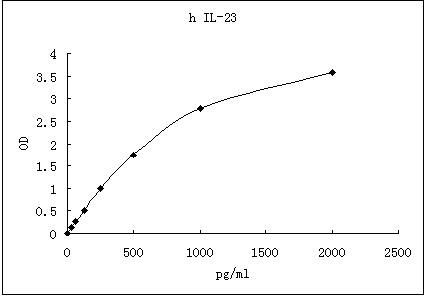Human IL-23 ELISA Kit (48-well)
CNY 2,890.00
Specifications
| Product Data | |
| Description | Human IL-23 ELISA Kit (48-well) |
| Size | 1 x 48 wells |
| Format | 48-well strip plate |
| Assay Type | Solid Phase Sandwich ELISA |
| Assay Length | 3 hours |
| Signal | Colorimetric |
| Curve Range | 31.25-2000pg/ml |
| Sample Type | Cell culture supernatant, serum, plasma (EDTA, citrate, heparin) |
| Sample Volume | 20 uL |
| Specificity | Natural and recombinant Human IL-23 Ligand |
| Sensitivity | 4pg/mL |
| Reactivity | Human |
| Interference | No significant interference observed with available related molecules. |
| Components |
|
| Background | Interleukin 23 (IL-23) is a heterodimeric cytokine that is related to IL-12 . It is composed of two disulfide-linked subunits, a p19 subunit that is unique to IL-23, and a p40 subunit that is shared with IL-12 . The p19 subunit has homology to the p35 subunit of IL-12, as well as to other single chain cytokines such as IL-6 and IL-11. The human p19 subunit cDNA encodes a 189 amino acid (aa) residue precursor protein with a putative 19 aa signal peptide and a 170 aa mature protein. Human and mouse p19 subunits share 70% aa sequence identity. The functional IL-23 receptor complex consists of two receptor subunits, the IL-12 receptor .1 subunit (IL-12 R.1) and the IL-23-specific receptor subunit (IL-23 R) . IL-23 is produced by dendritic cells and macrophages in response to pathogens including certain bacteria and viruses and/or their components . IL-23 and IL-12 have overlapping but distinct biological activities. The IL-23 immune pathway induces the earliest recruitment of neutrophils to the site of infection while the more classic host defense and cytotoxic response is stimulated by IL-12 . IL-12 drives the development of Th1 cells and induces production of IFN-. by NK cells . In contrast, IL-23 has a role in the development/maintenance of a T cell subset characterized by the production of IL-17A, IL-17F, IL-6, and TNF-. . The induction of IL-17-producing T cells may involve the actions of TGF-. while their survival and expansion may be IL-23-dependent . The IL-23/IL-17 axis is an important mediator of inflammation. In mouse models, transgenic over-expression of IL-23 leads to a systemic inflammatory response . IL-23 effects on IL-17-producing T cells may also enhance the development of several models of autoimmune disease including experimental allergic encephalomyelitis (EAE), collagen-induced arthritis (CIA), colitis, and diabetes (5, 8, 13-17). IL-23 may also play a role in increased tumor growth associated with chronic inflammation . In humans, IL-23 has been found upregulated in several pathologies with dysregulated immune function including psoriasis, CrohnÂ?s disease, and multiple sclerosis . |
| Gene Symbol | IL23A |
| Standard Curve |

Representative standard curve for IL-23 ELISA. IL-23 was diluted in serial two-fold steps in Sample Diluent.
|
Documents
| Product Manuals |


 United States
United States
 Germany
Germany
 Japan
Japan
 United Kingdom
United Kingdom
 China
China

